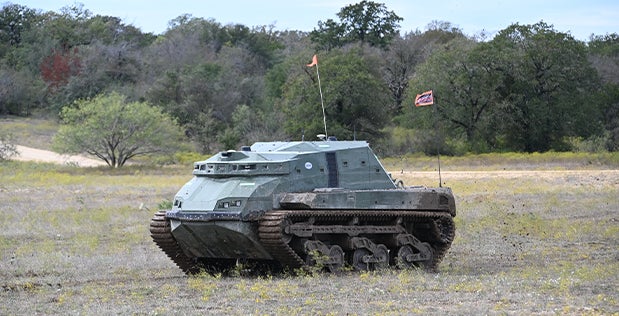DARPA’s RACER Program Successfully Demonstrates Off-Road Capabilities for Autonomous Vehicles
Last week, the US Defense Advanced Research Project Agency (DARPA) announced it had ran a series of successful tests as part of its RACER program in late 2023. RACER stands for “Robotic Autonomy in Complex Environments with Resiliency” and aims to advance AI algorithms for autonomous ground vehicles. However, while most self-driving car projects seek to adapt AI to operating on roads, RACER seeks to enable unmanned ground vehicles (UGVs) to traverse more complex off-road terrain as would be expected of vehicles in service with the military. The ultimate aim of the program is to develop autonomous systems which can move off-road at least as fast as human drivers. RACER focusses exclusively on software and algorithms and does not aim to advance vehicle or sensor technology.
The latest tests, part of the program’s second phase, applied algorithms to a larger variety of vehicles. Phase 1 experiments were conducted using only 11-foot-long (3.35 meter) 2-ton Ackermann-steered, wheeled RACER Fleet Vehicles (RFVs). Now, DARPA has added 12-ton RACER Heavy Platform (RHP) vehicles. With a length of 20 feet (6.1 meters), these tracked UGVs more closely reflect the types of platforms typically entering military service. In the words of RACER Program Director Stuart Young, the addition of this second platform “supports porting and performance demonstration of RACER autonomy stacks at multiple scales concurrently while moving between highly varied terrains”.
The phase 2 tests began with RACER experiment 4 (“e4”) featuring teams from the University of Washington and from NASA’s Jet Propulsion Laboratory. According to Stuart Young:
“Our Phase 2 off-road average autonomous speed goals are higher at lower intervention rates, and both RFVs plus now RHPs allow RACER to also show adaptability and resiliency of autonomous software at multiple, platform-agnostic ground robot scales in an array of complex, military-relevant environments. As we also add tactics-based autonomy, we see all of these together as vitally important to Army and Marine needs in robotic vehicle programs of record that are closely tracking RACER, and which represent possible transition opportunities for the program. […] RACER’s early Phase 2 activities, both with Experiment 4 performance successes in difficult, new-to-the-program, military relevant terrain in Texas, as well as recent incorporation of RHP as a fleet platform is setting the tone for the program to achieve tougher autonomous maneuver goals while showing autonomy resiliency and adaptability to new environments on any robot at any scale.”
The wheeled and tracked platforms were tested in terrain DARPA described as “highly diverse ground vegetation cover, trees, bushes, rocks, slopes, obstructed ditches, and creek crossings typical of the varied, complex Texas terrain familiar to armored maneuver”. The vehicles traversed courses which were 3 to 10 miles long 30 times “achieving over 150 autonomous, unoccupied miles at speeds up to 30 miles per hour”. Currently, two more RACER experiments are planned for 2024.

